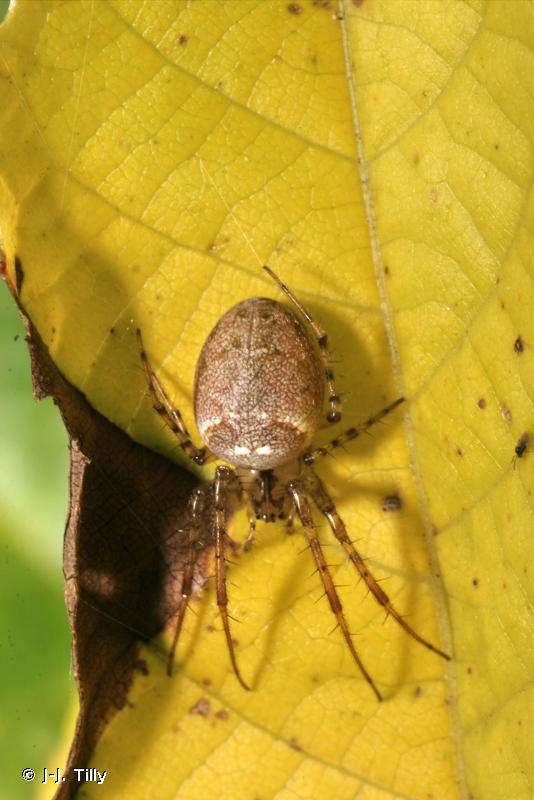
cd_nom

 |
To get the picture, please visit:
Jean-Philippe TABERLET
Association française d'arachnologie (AsFra)
e-mail : inpn@mnhn.fr
Legend: Mâle (gauche) et Femelle (droite)
Despite the Creative Commons license, please inform the author of the use which will be made of his photo

| Author : J-J. Tilly |
 |
To get the picture, please visit:
Jean-Jacques Tilly
Association française d'Arachnologie
http://asfra.fr/Site/Main_public.html
email : inpn@mnhn.fr
Any reuse of one or more photographs on this site is subject to an authorization request from the author.
Link to the Code of Intellectual Property (Legifrance)
Distribution mondiale
toute l'Europe, Moyen-Orient, Asie du Nord
Caractères distinctifs, espèces
Taille - femelle : 6-9 mm, mâle : 5-7 mm.
Il y a trois espèces dans le genre et deux dans un genre proche (Meta). Elle est particulièrement difficile à distinguer de M. mengei bien que ces deux espèces possèdent une physiologie et un comportement très différents.
Milieux colonisés
Elle colonise les bois et les forêts mais aussi les landes ou les jardins, en général dans des biotopes ombragés.
Chasse
La toile est caractéristique par son centre absent et par les rayons peu espacés (à la différence des Tétragnathes). Elle est tissée en oblique, assez bas dans la végétation. Elle reste en général sur la toile mais, parfois, elle se ménage une retraite à proximité de la toile, reliée au centre par un fil de rappel.
Développement, cycle
Les adultes apparaissent à la fin de l'été. La période de ponte a lieu de septembre à novembre. Le cycle est annuel en France mais pourrait se prolonger sur deux ans pour une partie de la population. Devenu adulte, le mâle se positionne à la périphérie de la toile d'une femelle. Il capture des proies interceptées par la toile de la femelle, les emmaillote, puis attire la femelle par une parade vibrée au cours de laquelle il offre le cadeau à sa compagne. La femelle pond plusieurs cocons (2-3) avant l'hiver. Les pontes ont souvent de moins en moins d'œufs. Le premier cocon peut atteindre une centaine d'œufs, mais il peut y avoir des cocons de moins de 50 œufs. Les œufs subissent une diapause embryonnaire levée par le froid. Les jeunes ne sortent des enveloppes des œufs qu'à la fin de l'hiver et du cocon qu'au printemps. Le développement est ensuite rapide, jusqu'à l'automne. Un jeune n'ayant pas atteint le stade adulte à l'automne peut passer un hiver supplémentaire. Son cycle sera alors de deux ans car les femelles ne pondent qu'à l'automne. Ces régulations du cycle comme la biologie sexuelle de la Meta printanière sont très différentes.
A. Canard(Université de Rennes/Service du Patrimoine Naturel, MNHN),2014
Continental
Metropolitan France
Overseas
Marine
Metropolitan France
Overseas
The map presents a summary at the 10 x 10 km grid of the observation data for the species transmitted to the SINP. These data have been subjected to validation filters.
The map presents a reference distribution layer of the species at the scale of departments and marine sectors. The presence and absence data were established by expertise within a network of partners. This reference distribution is used in the validation process of the SINP data at the INPN level.
Corresponds to a report on the basis of at least one observation proved within a period of 10 years (20 years for little-known invertebrates) preceding the year and no presumption of extinction since obtaining the last data nor doubt on reproductive and implemented nature of this population. For migratory species, the presence indicated concerns areas of reproduction.
This status is based on one or more of the following criteria:
This point covers the absence, more difficult by nature to demonstrate than presence. This status is based on one or more of the following criteria:
This status must be assigned to a department in which the presence of the species is casual.
Particular case of absence due to a proven extinction less than a half century ago (older disappearances are treated as "no probable or definite").
In the state of knowledge, we can not comment on the presence or absence in the current department. This is the default status when not comprised in one of the previous categories or whenever there is doubt.
The map shows the global distribution of the species based on GBIF data (Global Biodiversity Information Facility).
